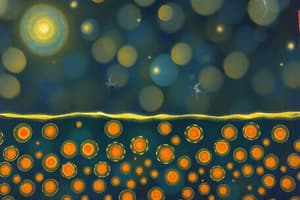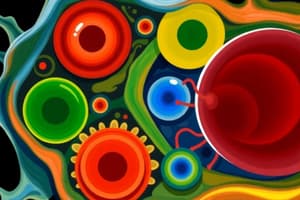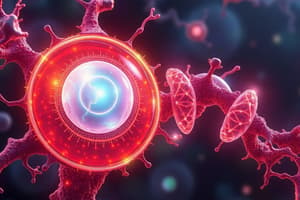Podcast
Questions and Answers
Which statement about the cell membrane is accurate?
Which statement about the cell membrane is accurate?
- It is impermeable to all types of molecules.
- It solely regulates water movement in the cell.
- It controls the entry and exit of substances. (correct)
- It allows all substances to freely enter and exit the cell.
Where does photosynthesis occur in plant cells?
Where does photosynthesis occur in plant cells?
- In ribosomes.
- In the nucleus.
- In chloroplasts. (correct)
- In mitochondria.
What role do glucagon and insulin play in the body?
What role do glucagon and insulin play in the body?
- They regulate blood glucose levels. (correct)
- They assist in the absorption of fats.
- They are involved in digesting proteins.
- They are responsible for oxygen transport.
Which term describes the process of converting glucose and oxygen into ATP?
Which term describes the process of converting glucose and oxygen into ATP?
What type of carbohydrate is composed of a single sugar unit?
What type of carbohydrate is composed of a single sugar unit?
Which organelle is primarily involved in the synthesis of proteins?
Which organelle is primarily involved in the synthesis of proteins?
What is the function of the cell wall in plant cells?
What is the function of the cell wall in plant cells?
Which of the following macromolecules is made up of amino acids?
Which of the following macromolecules is made up of amino acids?
What is the main difference between a prokaryotic and a eukaryotic cell?
What is the main difference between a prokaryotic and a eukaryotic cell?
Which organelle is responsible for photosynthesis in plant cells?
Which organelle is responsible for photosynthesis in plant cells?
Which macromolecule is primarily involved in storing genetic information?
Which macromolecule is primarily involved in storing genetic information?
What is the function of the Golgi apparatus in a cell?
What is the function of the Golgi apparatus in a cell?
Which of the following statements about ribosomes is correct?
Which of the following statements about ribosomes is correct?
Flashcards
What is the mitochondria?
What is the mitochondria?
The powerhouse of the cell, it produces ATP (energy) through cellular respiration.
What is the ribosome's function?
What is the ribosome's function?
The organelle that synthesizes proteins, the building blocks of life.
What does the cell wall do?
What does the cell wall do?
A rigid structure that surrounds plant cells, providing support and protection.
What is the key difference between prokaryotic and eukaryotic cells?
What is the key difference between prokaryotic and eukaryotic cells?
Signup and view all the flashcards
What are proteins?
What are proteins?
Signup and view all the flashcards
What is the chloroplast's job?
What is the chloroplast's job?
Signup and view all the flashcards
What is nucleic acid's function?
What is nucleic acid's function?
Signup and view all the flashcards
What does the Golgi apparatus do?
What does the Golgi apparatus do?
Signup and view all the flashcards
Cell membrane control
Cell membrane control
Signup and view all the flashcards
Photosynthesis location
Photosynthesis location
Signup and view all the flashcards
Glucagon and Insulin
Glucagon and Insulin
Signup and view all the flashcards
Cellular Respiration
Cellular Respiration
Signup and view all the flashcards
Monosaccharide
Monosaccharide
Signup and view all the flashcards
Study Notes
Cell Biology Vocabulary Test Study Notes
Part 1: Multiple Choice
- ATP Production: Mitochondria are responsible for producing ATP, the cell's main energy source.
- Protein Synthesis: Ribosomes synthesize proteins.
- Plant Cell Structure: The cell wall provides structural support and protection to plant cells.
- Prokaryotic vs. Eukaryotic Cells: Eukaryotic cells have membrane-bound organelles, while prokaryotic cells do not.
- Amino Acid Macromolecules: Proteins are made up of amino acids.
- Photosynthesis Organelle: Chloroplasts are responsible for photosynthesis in plant cells.
- Genetic Information Storage: Nucleic acids, specifically DNA, store genetic information.
Part 2: Short Answer
- Golgi Apparatus Function: Modifies, sorts, and packages proteins for secretion or use within the cell.
- Nucleus Function: Contains the cell's DNA, controls cell activities, and is the site of ribosome synthesis.
- Cellular Respiration: The process of converting glucose and oxygen into ATP, the cell's energy currency. Cellular respiration is vital for energy production in all living cells.
- Lysosomes: Contain enzymes to break down waste materials, cellular debris, and foreign particles. They are crucial for maintaining cellular health.
- Monosaccharide vs. Polysaccharide: A monosaccharide is a single sugar molecule (e.g., glucose), while a polysaccharide is a complex carbohydrate composed of multiple sugar units (e.g., starch).
Part 3: Matching
- A. Nucleolus: A structure within the nucleus that helps assemble ribosomes.
- B. Endoplasmic Reticulum (ER): A network of membranes involved in protein modification, folding, and transport.
- C. Cytoskeleton: Provides structural support and facilitates intracellular transport.
- D. Vacuole: A storage organelle, particularly for water and nutrients, especially in plant cells.
- E. Chlorophyll: A green pigment within chloroplasts that absorbs light energy for photosynthesis.
Part 4: True or False
- Mitochondria and Cellular Respiration: True (they are responsible in both plant and animal cells)
- Ribosomes in Prokaryotic Cells: False (Ribosomes are found in both prokaryotic and eukaryotic cells).
- Cell Membrane Function: True (It regulates what enters and leaves the cell).
- Photosynthesis Location: False (Photosynthesis occurs in the chloroplasts, not mitochondria).
- Glucagon and Insulin: True (These are hormones that regulate blood glucose levels).
Part 5: Fill in the Blanks
- Cellular Respiration Process: Cellular respiration
- Single Sugar Unit: Monosaccharide
- Pancreas Cells: Islets of Langerhans (or pancreatic islet cells)
- Protein Synthesis Nucleic Acid: RNA
- Brain Structure: Amygdala (plays a key role in processing emotions and survival instincts)
Studying That Suits You
Use AI to generate personalized quizzes and flashcards to suit your learning preferences.



